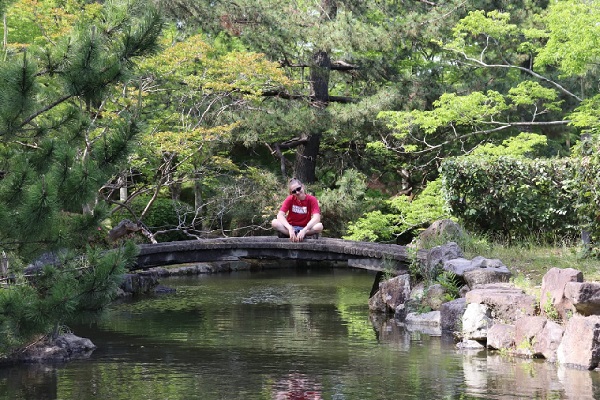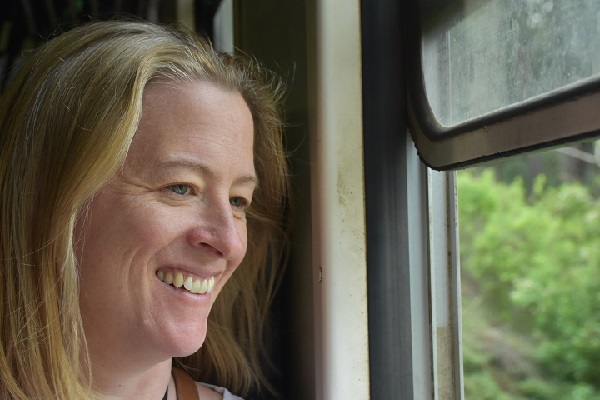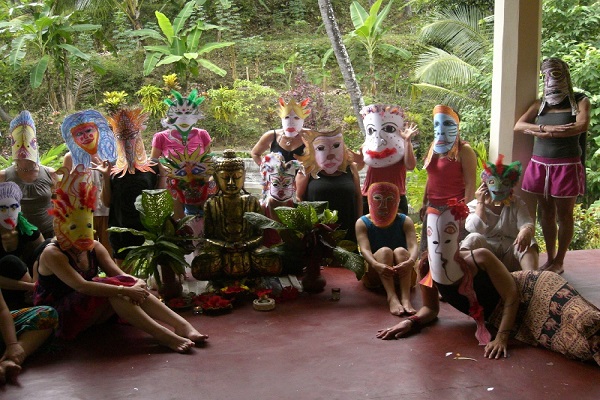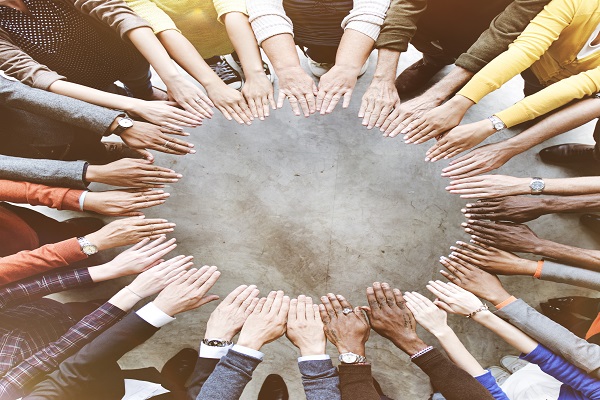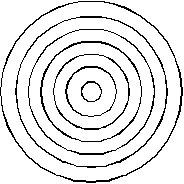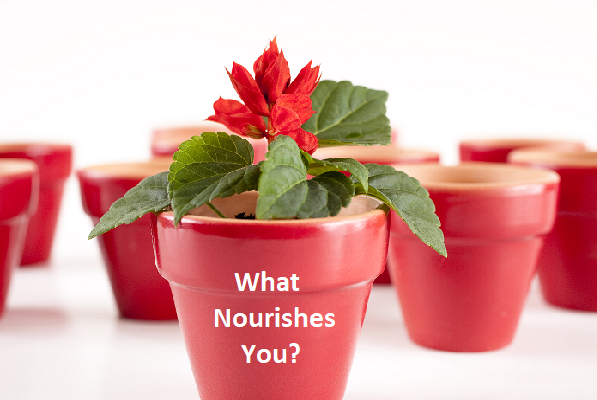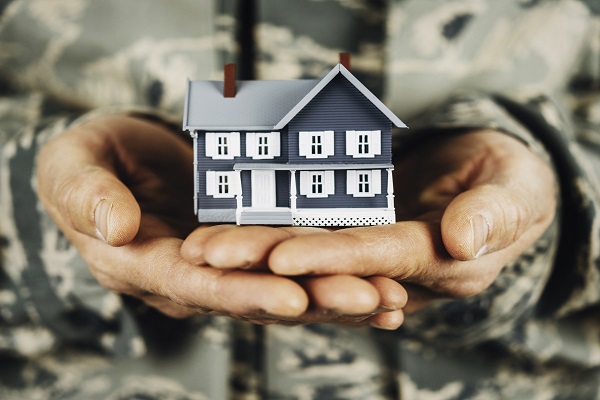This post highlights the importance of space and time to reflect away from the ‘noise’ of life to refocus on what matters so that we can see different perspectives, shift energy and beliefs that are stagnant and move forward with a clear and healthy intention that can restore connection.
This week I am working remotely from Bright in north-east Victoria. It’s become the space that I take to regroup, reflect and refocus a few times a year. I never really know what is going to surface at these times but have learned to just create space and get out of my own way. What surfaced on day one this week took me a little by surprise.
But first – a little of the back story so it makes sense.
A month ago my eldest daughter (age 19) announced that she was heading overseas on a solo adventure for seven – s-e-v-e-n – months to Japan and South East Asia then finishing in India and Nepal. I have witnessed Amelia working three jobs to save the funds for her adventure along with the clarity and conviction in her decision to defer from her second year of university. I have also known for some months that the trip was coming. But her intention had been to travel with a friend – the whole ‘travelling alone’ thing was new. And it really sent me into a spin. In fact, I went into a whole fear-based reaction that left me with nightmares about abduction in Japan. I had broken sleep, waking up asking myself ‘Is this really happening, or did I dream it?’ I was generally motionless and speechless for a day or two as I tried to process the news.
From Fear to Courage
Over the days that followed, I started to move beyond my own fear-based reaction. I was able to step a little more off the dancefloor and up to the balcony and a broader perspective. I was then able to see and be present with the extraordinary courage of this amazing young woman. Here I was a short jog away from 50 and I have never done anything as seemingly courageous as this. My broader perspective helped me to re-frame a number of beliefs and stories that were much more useful:
- If anyone’s got what this takes, she does. She’s street smart, savvy and quick to think and act when she needs to.
- She always attracts amazing people into her life. She knows how to have fun and have deep honest conversations and connection with people so interesting people are always drawn to her.
- From the moment she was born, she has always been well and truly looking out into this wondrous world – this is just who she is. She has work to do in the world and this is the natural next step – into the world.
- If life is not a daring adventure – then what is it?
- She’s ready to step away from home – and if we’re honest with ourselves, we’re ready for her to take that step away from home too. (We’re a bit over being treated like a hotel and in many ways, this is payback time – as I recall doing exactly the same with my mum.)
Secretly (or perhaps not so secretly now) there is also a part of me that would love to head out into the world just as she is, into an adventure into the unknown…
Roll forward to yesterday – day one in this next week of space in Bright.
I had been feeling something was stuck energetically in me all day long and I was getting frustrated because I should be working/ writing/ planning/ thinking … doing something! Then inspiration struck me. What was needed was a walk by the river with the dog, revealing in the present moment through the dog’s pure joy as she chased the ducks (no hope of catching them) and fetched sticks along the Ovens River.
Perhaps you have had a similar experience too? Trying so hard to ‘do’ and needing to make a decision just to ‘be’? I surprise myself at how often I fall into this same trap.
The Realisation
As I sat on the riverside listening to the birds and watching the water flowing over the rocks, I was struck by something in relation to my daughter. It was time to make a choice – a choice to let go. I hadn’t explicitly been thinking about her travel that day but clearly it was right there not too far from the surface, waiting to be revealed when I finally found the space to reflect.
‘“To let go means to let be. When we let be with compassion – things come and go on their own’
Jack Kornfield
Emotion rose and tears rolled down my cheeks as this energy that had been ‘stuck’ started to move through me – the realisation that that I had been emotionally holding on to my ‘baby girl’ for too long now.
I spent the next hours journaling and reflecting on what it meant as a mother to ‘let go’ with compassion and to ‘let be’. I also called on Google for some parenting advice and came across the following statement: ‘The most productive relationship for adult children is for them taking primary responsibility for their lives and parents acting as their consultants’. Okay. Yep. Well, that makes sense – I could certainly transition to that, if that’s what Amelia needs.
Change and Transition
In my work supporting leaders to navigate change in organisations I have often spoken about ‘change’ being the external act – the decision to go overseas, the leaving home, etc. in this situation. But then equally I bring focus onto the transition that change brings – that is the internal emotional changes that must happen through the cycle of emotions to arrive at acceptance. I could now see that clearly Amelia and I (and the whole family in fact) were in the midst of an important life transition.
‘Space’ Creates Insight
I’m not in the habit of always sharing personal stories on this blog however I share this story as a great example of the need to carve out pockets of space in our lives and/or moments to take a balcony perspective. Unless we do that, it can be difficult to see what is right under our nose.
Had I stayed in Melbourne this week, I would still be ‘holding on’, not seeing that it’s high time to let this gorgeous, creative, amazing, strong, self-focussed angel spread her wings.
Being a big fan of the healing power of ritual, right there by the river yesterday I carefully chose three healthy green gum leaves. As a I released them into the free-flowing water of the Ovens, from deep within the core of my being and surrounded with so much love I spoke these words:
“I choose to let you go.”
And I did.
Are you needing some space in your life right now to give yourself permission to do some inner processing? Schedule a conversation with Nicola to discuss how Leadership Coaching or our new Coaching Program – Cultivating Well for senior women can work for you or the people in your organisation.
In my next post I will explore why the practice of reflection is a leadership ‘super power’ and how to build it into your own leadership rhythm.
This post was orginally published in 2018
This post explores compassion and self-compassion through a personal story and invites the reader to reflect on their own levels of self-compassion based in the work of Kristin Neff.
Late last year I had a call from my daughter’s teacher. Chiara (age 15) was midway through a nine-week personal leadership experience based at Snowy River Campus in East Gippsland (provided by the Victorian government’s School for Student Leadership initiative).
The teacher shared with me the wonderful level of commitment, enthusiasm, goal achieving and social contribution that Chiara was making. When I asked her what she saw as the greatest development area for Chiara, she replied without hesitation in two simple words: greater self-compassion.
While this was not a surprise to me to hear someone else – with an opinion that I valued – reflect this back to me, I had a sinking feeling in my heart.
Instantly feeling ‘at fault’ as a mother (as we mothers can do so masterfully), I found myself thinking about the role model that I had been and still was for my daughter. I started wondering why it is often the case that those people who are the most kind and compassionate and loving to others find it hard to provide this same nourishment and nurturing for themselves?
It also got me thinking about the drivers that can contribute to this way of being. There’s the personal focus on external measures of success that are driven by an internal tendency to not feel good enough or worthy enough. These measures often create a false or short-lived sense of success. There are things that society values and that get rewarded in school, in the community and at home – being a ‘good girl’ and looking out for others, for instance. There are those things that take us away from feeling worthy of loving ourselves in the same way that we intrinsically offer love to the people in our lives.
‘Self-compassion is a measurable trait. In 2003 no-one had defined or measured it. In 2017 there were 1340 studies on self-compassion. Self-compassion is strongly linked to wellbeing.’ [ Source: Neff 2018
What is it to be compassionate?
Meet Chiara. Chiara is a gentle, kind and compassionate teenager who is wise beyond her years. She has natural care and concern for all living things – people, pets, trees. She takes great care in rescuing the spider or bug from her bedroom and returning it to the natural environment. She is empathic – she knows how others are feeling. She’s the kid who’ll notice the person in the corner who’s been excluded and approach them to make them feel not alone. She is the granddaughter who asks her nana from a place of genuine interest, ‘How are you Nanna? What’s been happening in your day?’, instead of a typical teenage response of a one-way street and it being all about her. She’s the first to make you a cup of tea if she senses you are out of sorts or need a bit of love.
Chiara is the kid who takes time morning and night to sit on the ground with the dog and give her some real care and attention. Each morning she appears at your side just like a pussy cat and wraps you in a blanket of love to start your day. Yes, we are truly blessed to have her in our lives.
So you see? She is actually one of the most compassionate people I know and such a great teacher to me and to her sisters and peers. Compassion is the essence of this young lady. She knows it well.
Turning this compassion that she knows so well into watering and nourishing herself – that would appear to be the next step in her learning journey. And I know she is not alone. I for one need to turn up this dial on self-compassion. Perhaps you do too?
This might help:
In the later part of 2018, I attended a workshop with Kristin Neff, a world expert on self-compassion. Part of what she offered was a radical shift to ‘relate to self’ in new ways.
Kristen defines self-compassion as:
- being a good friend to yourself
- treating yourself the way you would treat a good friend; and
- holding pain with love.
She took us through a three-part reflective process, which I would like to offer you here:
Part 1
Allow a friend to arise in your mind’s eye. Allow a close friend who is suffering in some way to appear in your mind’s eye, in a situation where you are feeling resilient and strong.
Close your eyes and ask yourself this question: How would I treat this close friend?
What are the types of things you would say to your friend?
What tone do you use?
What’s your body posture like?
What type of non-verbal gestures do you use?
Part 2
Allow to arise in your mind’s eye a situation where you failed at something important to you or you are having a hard time.
What do you say to yourself when you are struggling?
How did you say it?
What is your body posture?
How do you relate to yourself when you are struggling?
Part 3
Do you notice any patterns of difference between how you treat yourself when struggling and how you treat others when they are?
What did you discover about how you treat yourself/others?
Perhaps you might like to share your reflection with a friend?
In our work with leaders – amidst the harsh demands of work and life, the absence of self-compassion is palpable. In our quest to be better, do better, earn more, get the promotion, any notion of self-compassion gets lost.
I invite you to explore the wonderful books and resources that are available on Kristin’s website.
Is there one small step you can take toward greater self-compassion?
PS. Chiara is now several months back from her life-changing leadership experience. The young lady we have here with us now is more confident, self-empowered and self-aware than I thought was possible in such a short space of time. She’s made decisions and choices this year to show more self-compassion and of her own accord has continued a daily journaling practice. She’s followed her inner-knowing and desire to do things that bring her joy (she practices yoga several times a week, walks the dog regularly and is playing netball for the first time). She is also a daily reminder to me that I have a choice.
In my previous post, I explored the seven circles and invited you to consider who is in your first circle and whether it is time for an overhaul. In this post, I want to share with you my personal experience of finding my tribe and offer some tips for finding your own tribe.
In 2012 on the far side of Bali, without a single traffic light or ATM, I arrived in a place called Tejakula and both a mountain retreat and beachside delight for every part of my senses. I had made a decision to take time away from my family and to travel alone – my first time for both – to attend a week-long art therapy conference with 24 others.
I settled into my accommodation on the beach along with four other women. Apart from two sisters, none of us knew each other. From there we travelled via motor bike to the main road and then up to the top of the mountain in a ute where the retreat was being held. This was to be our twice daily ritual: from the ocean to the mountain, from the mountain to the ocean. The five of us instantly found an incredible bond, soon feeling like friends who had known each other for years.
On the morning of the first session, I felt emotion rising as we approached the mountain top destination. I found myself in an open-air studio in this healing oasis sitting next to the bronze statue of Buddha. Tears of sadness and joy ran down my face.
In that moment and for the rich days that followed I was struck by the realisation that I was here amongst my tribe. I had never known such a feeling of belonging. In fact the whole idea of ‘tribe’ was something I had never even thought about. The fact that I didn’t have a tribe or that I needed to find a tribe had never occurred to me. There I was with a group of 25 strangers feeling more at home, and more seen and validated, than I had ever known.
Amongst this experience of pure sensory delight, experiencing the local rituals and art process, something within me was awakened. This was one of those times in life where I turned a little more towards who I am at the core.
I am so grateful I backed myself enough to take that trip.
This experience quickly set a fire in me, leaving me with a very clear intention before I left Bali: to find my tribe at home that worked in the same professional arena as me – the leadership development space.
I didn’t have to wait too long. Within a week of returning home, I met two of my now closest friends and confidantes via an introduction from a mutual friend. They are very much tribe and we are that for each other.
Over subsequent years I have been very fortunate that this tribe has grown. In terms of the seven circles, that has meant that many of my older friendships, based on outdated versions of me, moved out a circle or two while remaining important in my life.
Having a tribe, my tribe, has helped me learn to express, to connect deeply and to be present for another. In those inevitable hours and days and weeks when I feel overwhelmed (as a highly sensitive person often does – it is a shadow of this trait) or I’ve lost my way, its my tribe that help me remember who I am. Through being able to express and share even the most intimate or terrifying thoughts and feelings, I have been able to heal, to grow and to become a more useful version of me.
I share this story in the hope that it might make a difference to one person, in the choices they make and intentions they set around the people they include in their first circle.
I recognise that having a tribe is not something that everyone yearns for, and if you feel your needs are well met in the first circle just as they are, then that is of course perfectly fine for you (and I hope you have enjoyed reading this little travel blog)
If you do however have an inner yearning to grow or start your tribe, here are some tips that might be useful for you:
- There is a tribe out there for every single one of us but it’s not likely to come and tap you on the shoulder! So set your intention and take action towards finding your tribe.
- Consider people in your life who you think you might like to ‘test’ inviting into the first circle and create opportunities where you can be on your own with this person and ‘put a bit of skin in the game’. This means offering up something personal (a little bit edgy, but not so much that it will make you feel too vulnerable) that you wouldn’t usually share with this person and see where the conversation goes. It’s a bit like putting your foot in the water to test the temperature.
- Sometimes we have to ‘look outside’ our current friends, family and social networks to find our tribe. At least that was my experience – it may not be yours. The best way of doing this is to put yourself into new situations doing something that you love to do (maybe an art class, a wine club, a personal development experience, etc).
- Become a better version of your own tribe – seek out opportunities to learn and grow and develop and reflect and express and write. You could use our to set you on your way with this. This is about becoming a better friend for yourself.
- Perhaps you are a highly sensitive person like me? If you think you might be but you’re not sure, take the HSP test and if that leans you towards a yes or a strong yes, please send me an email. We have a number of ‘HSP in Business’ specific events in Melbourne where you can seek out and connect with other HSPs.
And finally, a closing note of acknowledgement for my tribe:
To my tribe. You know exactly who you are. This is for you.
Thank you from the core of my being for teaching me how:
To be present, by being present,
To listen deeply, by listening deeply,
Not to judge, by never judging,
Not to blame, by never blaming,
To welcome all of our human gifts and imperfections, by welcoming all of my human gifts and imperfections,
To lovingly hold the space for another, by lovingly holding the space for me.
You are the wind beneath my wings, and the light that shines so brightly even in the darkest moments.
I am so deeply grateful that we found each other, and I feel so blessed to be walking this path with you.
With deep gratitude, Nicola x
This post is about an idea called ‘The Circles’ from a little book by the same name. It invites the reader to reflect on the people they place in their first circle and to make a conscious choice about whether that’s working well or might need a some change.
I stumbled across a little book collecting dust on my daughter’s bookshelf. It’s called The Circles and was written by well-known Australian actor Kerry Armstrong. The purpose of the book is to help the reader to take a helicopter view of their feelings towards friends, family and colleagues and to map them to one of seven concentric circles.
I’ve found the book helpful as a ‘check in’ for myself, and I thought it may be useful for you too – particularly as we enter a time of the year when, hopefully, most of us will find some time for reflection.
Each of the seven circles in the book represents where people are in your life and your relationships to them. The first circle is for those people who make you feel good about yourself, while the seventh circle is for the people you find most challenging. The author is quick to mention that who you place in each circle is entirely up to you, and that it’s important for you to know that this will change – and that you can choose to make changes at any time.
In this post I want to focus on the first circle.
The author explains that the first circle, the one right in the middle, is where you get to express all your hopes, dreams and thoughts. She invites you to put yourself in the centre of that circle and ask yourself:
Who knows me here?
Who can I trust with my life, my thoughts, my dreams?
Who makes me feel free to be myself?
In other words, who would you have inside that first circle with you?
Perhaps you might like to take a moment to do that for yourself? What do you notice?
The Circles got me thinking about and truly appreciating the people who are in my first circle. It also got me reflecting back to a time in my life when I didn’t even know that was missing. It took me many years to find my tribe and it was a surprising lesson to learn that, in the main, my tribe is not my family. (This is something I will share with you in a future post.)
The book also got me thinking about how supportive and enabling it is to have people in my first circle, how these people have helped me (and continue to help me) navigate the complexities of life situations and depths of emotion that I regularly experience (exacerbated by being a highly sensitive person, or HSP).
Just knowing that I can share absolutely anything with someone in my first circle without being judged; that I can pick up the phone to one of them at any time and have a much-needed rant or cry or laugh or celebration and will always be meet with unconditional love. This is such a liberating feeling. Not surprisingly, this type of arrangement is often reciprocated, especially with my first circle friends. (It has taken years of getting to know myself better to be able to begin to cultivate this.)
I haven’t written this post as a ‘you must be like me and have someone in the first circle’ rant. It is important to acknowledge that some people, for a variety of reasons, prefer to stand in the first circle alone, and that may well be exactly what works for them. We are all different so as long as we are choosing consciously what works for us and making changes when things don’t work for us, the rest is irrelevant.
However, for me having company inside that circle does matter. Any here’s why:
As human beings, we are designed to ‘feel’. Part of managing ‘feeling’ is having someone with whom you are completely comfortable and safe expressing how it is that you are feeling. Someone who won’t judge you or blame you, who won’t try to fix you and who is available to listen deeply to you. That’s how we move through strong emotions and in doing so learn about ourselves and the world around us: by expressing them.
For those who are happy alone inside the first circle, they may find that expressing their feelings somewhere – through journaling or creative expression of some kind, for instance – is enough. But for me and many others, it needs to be another person.
However you do it, it is important that we regularly express how we are feeling in some way. If we start to hold onto all of our worries, literally inside our bodies, this affects our physical, mental and emotional wellbeing. We can get sick, lose sleep, worry unnecessarily. If we have a predisposition towards mental illness, the inability to express feelings can be a trigger for that too.
I encourage you to take the opportunity to ponder and consider: Who is in your first circle and is that working well for you? Or is there an opportunity for an overhaul?
In my next post I will share some tips for attracting the tribe that is perfect for you.
This post explores the power of three simple words: ‘What nourishes you?’ I consider these words in the context of personal reflection, to deepen connection with one’s internal motivation for self-care. I also explore them with an application of symbol cards and as a conversation opener and shifter to a topic that matters and strengthens connection.
At a recent leadership conference themed around connection, we began with a conversation around this question: What nourishes you?
These three simple words quickly bypassed the minds and engaged the hearts of the group as people pondered and shared their responses. Feedback from the group indicated that they loved the question and were delighted at how it offered a fresh internal insight and perspective, taking conversation with their partner into new terrain.
The reaction of this group was the same as that I have seen with many individual leaders and teams who are asked the same question. Which raises a red flag. Why do we not ask ourselves this question? Why do we not ask it of each other?
If we are walking and leading in life without bringing attention to what nourishes us, how can we know what form of self-care is right for us on the path towards wellbeing? How can we know what needs to change?
These three little words – ‘What nourishes you?’ – are a great place to start with your personal enquiry, bringing greater focus to your own self-care.
A case study: the horse, the ocean and the mirror
 I have been successfully using the ‘What nourishes you?’ question in different applications across a decade or more. I want to share an extended version of this application that deepens the individual’s inquiry.
I have been successfully using the ‘What nourishes you?’ question in different applications across a decade or more. I want to share an extended version of this application that deepens the individual’s inquiry.
During my training to become an art therapist, I worked with a 20-year-old client who had a history of anxiety and depression. She had spent many years under the care of psychologists and a psychiatrist. She wanted to try a different approach.
Through the use of symbol cards we explored ‘What nourishes you?’. Somewhat surprising to me at the time, it turned out that in over a decade or more of therapy this woman had never been asked a question filled with such possibility. Rather, she had found herself rehashing the problems of her life again and again.
“Symbols evoke profound emotions and memories, often without our making rational or conscious connections. They surround us and they help navigate through life, providing short cuts to understandings, ideas and feelings … the use of visual images can assist a client to get in touch with otherwise inaccessible personal realities” – www.innovativeresources.com
How does it work?
By asking ‘What nourishes you?’ and inviting a spontaneous selection of symbols as a response, we bypass the left logical brain (our verbal language centre) and instead access our right-brain intelligence. This is our creative side, so accessing it invites a deeper knowing – something from our unconscious self – to emerge.
I recall a beautiful moment when this young woman selected three symbol cards: the horse, the ocean and the mirror. She was still. Emotion rising. We sat there together in the magic of this moment. Something shifted within her inner experience and possibility. Life beckoned.
What began as a symbol exercise about ‘What nourishes you?’ turned into a deeper exploration and ultimately deep clarity and insight into how this young woman wanted to be in the world. Standing tall, centred and powerfully on her own feet like the horse; loving who she saw when she looked in the mirror and not shrinking when she met the world; and feeling free like she felt in the ocean.
This young lady experienced a connection with her internal navigation system and connected with how she wanted to be in the world. This was an unlocking of something previously locked so tight it was not available to her.
Application to learning and leadership development
While clearly this specific experience was within a therapeutic situation, I use symbol cards with project teams that are misaligned and off course and as a conversation starter, connector and to bypass mental chatter in leadership development. (NB. the actual question I ask will depend on the specific learning context, for example, in a recent leadership development program in which we were exploring change, the question was “What is Change?”, using the symbol cards to invite a deeper response to this question. Similarly, with project teams that are stuck – I might ask “How do you feel?”, which invites the individual’s experience of what is going right/wrong with the project to surface so that everyone’s voice is heard and the team can navigate next steps from an authentic place.)
This application of symbol cards – as an adjunct to coaching or team development – is broadly available and accessible to coaches and facilitators. I have included the link here to buy your own set of symbol cards if you feel inspired to give symbols a go.
What nourishes you? – getting started
Whether you are a coach, facilitator, leader or person wanting to build connection, I encourage you to ignite this conversation in your team, your family and as a conversation starter in any context:
- Start close in: ask yourself ‘What nourishes me?’; ‘Where is that in my life right now?’; ‘How much time and energy over the past week has been allocated for my own self-care?’; ‘What needs to change?’ Commit to one small step today that will take you a step closer on the path toward wellbeing in life and leadership.
- Ignite the conversation in your team and with the people closest to you in your life by asking the question often: ‘What nourishes you?’ or use the symbol card process to ignite another important question for example, “How do you feel”?
- Coach, therapist or facilitator? Consider incorporating symbol cards into your practice with the ‘What nourishes you?’ question and many more.
To commit to self-care is to value yourself, your relationships, your professional work. Self-care is a choice you make. It starts with you. These three little words – ‘What nourishes you?’ – are a great place to start with your personal inquiry and as a conversation opener and shifter to a topic that matters.
This article explores the (not-well-understood) fact that twenty percent of the population have a high sensitivity personality trait. It invites a call to action for leaders and diversity and inclusion practitioners to get on-board with this, and to help these people better understand themselves and to work alongside them to make changes to the work environment to serve individual well-being and to harness this untapped potential.
Last year I ran a particularly engaging and heart-opening workshop as part of a company’s diversity strategy. The workshop turned what was normally a very dour, windowless boardroom into a place infused with energy.
At the end of the day, after all the participants had left, I was still on a high from the experience when the managing director (who was very supportive of our work) popped into the room. He asked how the session went and I shared the excitement and outcomes of the day. I then said to him, ‘Can you feel the energy in the room?’
He looked at me with deep respect (knowing that I could in fact feel the energy in the room) and said, ‘No, Nicola. I can’t feel the energy in the room.’
We both paused and smiled. It was a moment of acknowledging diversity, in the true spirit of the workshop that had been just been held.
That day was a reminder for me of a gift that I have come to take for granted given that I live with it every day. The gift relates to my high sensitivity, which gives me access into so much of what remains invisible to many others.
I had long recognised my high sensitivity but didn’t really give it a name until I came across a book titled The Highly Sensitive Person by clinical psychologist and researcher Elaine N. Aron. My discovery of this book was one of those life changing moments. Reading it helped me to own more of who I am and to stand taller in the world, recognising that my need for self-care – including having time and space alone and avoiding caffeine (one coffee keeps me awake for 24 hours) – is as essential to me as eating, sleeping, and breathing.
20 per cent of the population are born with a highly sensitive personality trait
Highly sensitive herself, Elaine Aron has done years of research and has discovered that ‘sensory processing sensitivity’ is a personality trait that 15 to 20 per cent of the population are born with. Twenty per cent! This means that up to one fifth of the population (and therefore the workforce) has this gift.
What are the traits of a highly sensitive person?
Biologically, highly sensitive people (HSPs) are different to the rest of the population. Their minds work differently. HSPs react more to stimulation: they notice levels of stimulation that go unnoticed by others. They are more easily overwhelmed, need more down time and more time alone and are prone to illness when they ignore their HSP trait.
A common misunderstanding is that HSPs are all introverts, where in fact 30 per cent of all HSPs are extraverts. HSPs have access to what is known as the ‘sixth sense’, which gives access to intuition where they just ‘know’ what a particular outcome of a situation will be ahead of time. They will often know intuitively what decision to make without the need to process it logically or rationally.
Aron uses the acronym DOES to summarise the key facets of this trait:
D: depth of processing – a fundamental characteristic is that HSPs observe and reflect before they act.
“Like those machines that grade fruit by size, we (HSPs) sort the fruit into 10 sizes while others sort it into 2 or 3.” (page 7)
O: easily over stimulated – if you are going to pay more attention to everything, you are bound to tire sooner. Moderate arousal for the rest of the population equals high arousal for a HSP. High arousal for the rest of the population equates to overwhelm and can cause shut down for a highly sensitive person.
E: giving emphasis to our emotional reactions and having strong empathy which, amongst other things, helps us to connect with others, to notice and to learn.
S: sensitive to all the subtleties around them which is often what it most apparent to the HSP – the little things they notice that other miss.
Wondering if you are HSP?
You can do a self-test on Aron’s website based on her work. It will indicate whether you may have the high sensitivity trait. If you find that you could be, I would encourage you to reach out and get the support of a coach or therapist if you feel that would help you to integrate your new insights about yourself.
My intention for sharing
I wanted to share this brilliant work in the hope that if you too feel that you are different (in this highly sensitive way) to many of the people around you, that by understanding this trait you can more fully appreciate yourself. Celebrate your gifts and give yourself the self-care that you need to flourish. Read more about this trait and begin to help others to understand and appreciate your sensitivities. If you are a leader, parent, spouse, or friend of someone who is highly sensitive, the resources can be tools for you too, helping you to start a different conversation and to invite a new level of appreciation and respect.
The implications for diversity and inclusion, leadership and organisations
Aron’s work has got me thinking about HSPs and the need for organisations to bring focus to this area as part of their diversity and inclusion agenda. This is clearly a diversity and inclusion issue and an opportunity for leaders to bring to the surface the gifts and needs of this currently unidentified group of people that make up 20 per cent of the population.
>>>>>>>>>>>>>>>>>>>>>>>>>>>>>>>>>>>>>>>>>>>>>>>>>>>>>>>>>>>>>>>>>>>>>>>>>>>>>>>>>>
Interested in a presentation on this topic for leaders in your organisation? Contact Nicola
There was a period in my life when I found myself in a state of overwhelm – the type of overwhelm that everyone else can see except the person being overwhelmed (i.e. myself). I wouldn’t recognise it until some time later. During this time, a leadership coach introduced me to the concept of ‘mental real estate’. It was a classic ‘light bulb’ moment.
Our mental real estate is the capacity we have to hold onto, manage and navigate everything in our lives. Our work, our relationships, our family. Our day-to-day responsibilities in the many roles that each of us have: leader, partner, parent, sibling, child, friend, colleague etc. Perhaps our community work or volunteer work at school or elsewhere.
Mental real estate is not an infinite resource
The thing about mental real estate is that it’s not an infinite resource. The amount each of us has is finite.
Just like ‘real’ real estate, mental real estate has boundaries that can’t be expanded. The more we commit to extra things in our lives – the more we say ‘yes’ to every request or offer – the more our mind starts to push up against those boundaries.
Eventually it becomes like overpacking a suitcase and then still trying to get more in: something has to give. This is where we are over committed.
The impact of this situation will be familiar to many leaders and other busy people. We start to lose focus on the things that really matter to us. We get locked into ‘thinking and doing’; we lose the ability to ‘feel and be’. We become overwhelmed, as I was. Stuck on a treadmill, we become overly stressed – certainly stressed beyond a healthy level – and start making poor decisions. This diminishes our wellbeing and starts to affect our happiness, relationships and overall performance.
It’s important to realise that, just like the real estate we live in, a lot of what is crowding our minds in these situations is clutter we don’t really need. As many as 80 per cent of the thoughts we have each day can be unhelpful in the sense that they aren’t moving us toward the life we want to lead. All this mental clutter gets in the way of our ability to thinking clearly and making good decisions and can lead to unnecessary overwhelm. Reserving as much mental real estate as you can for the stuff that actually matters is the key here.
Take a moment to reflect on your own mental real estate
I invite you to take a moment to reflect on the three things that matter most to you in your life: the things that make you feel full, happy and satisfied.
Now ‘zoom out’ to take in everything that you have on your plate right now. All the tasks and roles that you are (or feel) responsible for right now.
Is there an alignment? Is the stuff that is keeping you busy, and therefore occupying most of your mental real estate, contributing to those things that are most important to you? Are you making a concerted effort to ensure that some of your mental real estate is reserved for those important aspects of your life?
Or is this exercise simply too hard due to your mental real estate being overcrowded?
What do you notice?
Does something need to change?
When I did this exercise some years back, I noticed that I the things that my focus was definitely no on those things that mattered the most to me. They were struggling for a place in my mental real estate, and as a result I had little clarity of thought and was making poor decisions. To help get me back on track, I called upon a personal values assessment.
Taking the time to explore your personal values and beliefs is a great way to get started on an ‘audit’ of your mental real estate. This process can guide you back to what is most important to you, and from that place you will be better equipped to make conscious choices about what needs to be let go of to clear a bit of space in your mental real estate.
You also might like to consider the completion of a Global Leadership Wellbeing Survey (GLWS). This survey will help you understand your state of wellbeing at work and at home. It will help check in on your available mental real estate. The survey is supported through a debrief and development conversation to help you ‘tidy up’ your mental real estate, establish a sustainable self-care rhythm and show up as a better version of you.
Our mental real estate is a precious commodity. Do what you can to keep yours tidy, ordered and not too cluttered.
This article is a resource for anyone who has signed up for Mindful in May 2018 ( and equally applies to any other similar self-care challenge). It outlines 8 key steps for you to consider to set yourself up for success.
I was preparing this “Setting yourself up for success” handout to provide at a launch of Mindful in May at corporate client in Melbourne this week and it struck me that this information might be useful to a broader audience involved in Mindful in May- so here it is hopefully with a gem or two for you to get the most out of this challenge.(NB. It equally applies to any new self-care program that you might be considering too)
1. Be clear about what you are committing to upfront – Setting an Intention and Goals
I recommend setting an intention for the whole month and a goal for each week. Intentions are more about deciding ‘who’ you want to be and ‘how’ you want to show up, for example: your intention might be to keep showing up with the practice even when you don’t feel like it / or your intention might be to act with self-compassion throughout this experience.
Goals are about what you want to ‘do’ or accomplish. You might be better to start small. For example, maybe you set a goal for the first week to do four out of seven days and then review at the end of the week. If you end up doing it each day, then that’s a bonus. Repeat this each week. Review your intention and goals each week and refine so it feels right for you.
2. Decide on a regular time to do the practice.
Block it out in your calendar just as you would any other meeting. This is time for you to be with you. Block out half an hour so you have time to arrive get set up and space at the end to reflect or journal.
3. Attach it to an existing habit.
For example, if you get up each morning and the first thing you do is make a cup of tea, add your new step ‘do my meditation’ right before that one. So now you get up and sit in a chair in the lounge room and do your meditation, then have your cup of tea. Or in the evening, this time linking the new habit (the daily meditation) to cleaning your teeth, for example. (Charles Duhrigg’s book The Power of Habits is a great read on this topic.)
4. Set up the physical environment.
Where will you do your practice? Setting it up in the same location is the best way to establish a habit. What do you need to be supremely comfortable? A chair? Cushions? A blanket? A sign on the door to let others know not to interrupt is a great idea. What other distractions need to be removed from the space? If you are doing it at home let your family/kids know the what and how long you will be. (Pets and kids will be drawn to you when you meditate as they love how it feels).
5. Make sure your technology is working.
So you’ve set your intention and goals, your feeling mentally prepared and physically prepared and then your technology doesn’t work! Get your technology sorted ahead of time – what device will you use? Check that it is working ahead of time. Make sure your calls, messages and any other beeps and blips can be turned off during your practice. I recall running a group session last year for mindful in may and my computer froze all together five minutes into the meditation! It was not ideal. Please avoid that for yourself!
6. Holding yourself to account.
Decide if this is a solo adventure for you or if you would benefit from a buddy or buddies to share the experience with and help hold each to account. It’s your choice – make a conscious choice and set your self up with the support that you know that you need. If you do decide the buddy option decide whether you will meet each day to do the challenge (or not) but be sure to then schedule a weekly check in time to share your experience and to re-visit and refine your goals and intentions.
7. Keep a journal
Buy yourself a cheap notebook, nothing fancy and at the end of each 10 min session, take a few moments to reflect on how you felt before the session, how you feel now, how you found the practice today, what you noticed in your body and any other observations.
8. Sharing the love.
During the challenge share with others (your family, friends work colleagues) how you are finding the experience, what you are learning, which teachers are most inspiring etc. The world will be a better place when more and more people start to prioritise their own self-care needs. Mindfulness is a great way to begin that journey. If your kids are keen to get involved – that is fantastic – as a mother of three teenage daughters, I know more than ever how much kids need to add this skill to their ‘life toolkit’ too. In terms of the best way to approach, this I recommend still doing your practice AND then making a separate time to repeat one or more of the experiences that you have had with your child/children. (An important part of this process is this is about you claiming your own self-care space so its important to keep that healthy boundary).
Congratulations on taking this journey to take better care of you. I would love to hear how you go!
Has this been helpful? Are you interested in something more?
Perhaps you are needing an overall wellbeing health check? You might like to consider the completion of a Global Leadership Wellbeing Survey (GLWS) . Designed for senior leaders, this survey will help you understand your state of wellbeing at work and at home and is supported through a debrief and development coaching conversation to help you establish a sustainable self-care rhythm and show up as a better version of you. An eight week Wellbeing Assessment and Development Program (WADP) is also available for senior leadership teams to shift the dial on wellbeing and performance to drive cultural change.


